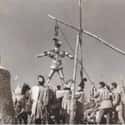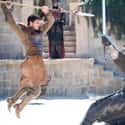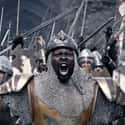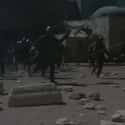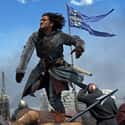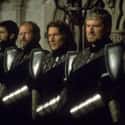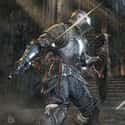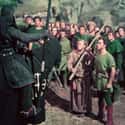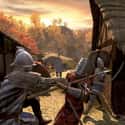-
(#1) When They Weren't Fighting, Knights Went On Adventurous Quests
The Trope: Heroic knights-errant embark on quests to rescue a damsel in distress, track down the Holy Grail, or defeat a monstrous villain.
Why Is It Inaccurate?: Historical knights were warriors, land owners, and politicians - they didn't have time to embark on semi-mythic quests. Knights may have invoked a higher purpose for their fights; the Crusades, for example, were framed in religious terms. Knights could also go on pilgrimages to holy sites in places such as Santiago de Compostela, Rome, and Canterbury. But the idea of a knight-errant journeying on a personal quest is more fiction than fact.
Notable Offenders: The trope of the questing knight-errant can be traced back to medieval literature and the tales of fictional knights like Perceval and Sir Gawain. Filmmakers deployed this old trope in movies and TV series like Excalibur, Knightfall, and Quest for Camelot. The trope even got a modern spin in Indiana Jones and the Last Crusade.
-
(#2) The Mounted Knight Was The Most Important Force On Every Battlefield
The Trope: Knights were the medieval military's VIP fighters who could make or break a conflict.
Why Is It Inaccurate?: Knights were undoubtedly a crucial component of medieval military tactics. Armies that lacked armored knights were often overwhelmed by opponents who used them, such as when mounted Norman knights defeated English foot troops at the Battle of Hastings in 1066. But knights weren't invincible. By the late Middle Ages, better technology had made knights more vulnerable, since instruments like longbows, crossbows, and eventually arms could penetrate their armor. During the 100 Years' War, for example, the English longbow was an important tool in some of England's victories. Knights weren't always deciding factors in acts of conflict, either. Sieges relied on a variety of troops and technologies.
Notable Offenders: Thanks to courtly romances and Arthurian legends, pop culture - including films like Ironclad and First Knight and television shows like Knight Fight - fixates on knights as the ultimate medieval fighter. Video games that enable players to adopt the POV of knights further invoke this trope.
-
(#3) Knights' Armor Was So Heavy That They Needed To Be Hoisted Onto Their Saddles With A Crane
The Trope: Armor weighed down knights so much that they couldn't lift themselves into their saddles. They had to rely on cranes to hoist them.
Why Is It Inaccurate?: If knights donned armor so heavy that they couldn't mount a horse, they wouldn't have made much of a fighting force. Knights' primary function was to fight on the battlefield; they needed to be agile. While armor added weight and sometimes required knights to expend more energy, knights trained to wear armor. The kind of armor knights used changed over time, ranging from relatively light chain mail, which would have weighed around 30 pounds, in the 11th and 12th centuries to plate armor in the 15th century. The heaviest armor was used for tournaments. The weight of armor aside, it would have been wildly impractical to rely on cranes and requisite manpower to hoist every single knight onto his steed before a clash.
Notable Offenders: One of the first films to wrongly portray knights relying on a crane to lift them up was Sir Laurence Olivier's Henry V from 1944.
-
(#4) Knights Would Spin Around While Dueling And Blindly Slash At Their Opponents
The Trope: Medieval knights fought duels with a flourish.
Why Is It Inaccurate?: Since duels were draining, knights would not have wasted precious energy on acrobatics. Duels were a means for knights to settle personal and legal disputes and display their prowess. Indeed, knights were skilled, trained fighters: The emphasis was on aggressive, rather than defensive, moves. Duels also involved bloody hand-to-hand combat.
Notable Offenders: Though the television series Game of Thrones is fantasy, it draws from the medieval world - but that doesn't mean it's accurate. For example, Oberyn Martell's high-flying theatrics during a duel bear little resemblance to how European knights actually fought. On the other end of the spectrum, the History Channel's Knight Fight is more interested in brawls than demonstrating the masterful skill that medieval knights would have honed during their many years of training - the show wrongly presents knights as unskilled brutes.
-
(#5) Knights Only Wielded Heavy, Mighty Swords
The Trope: Whether carrying, wielding, or wearing it, a knight isn't a knight without a sword. Knights revered swords so much that they gave their tactical tools names.
Why Is It Inaccurate?: Knights really did value swords, especially since they were often status symbols, and some historical figures named their instruments, like Charlemagne's Joyeuse. Medieval swords weren't as heavy as most people imagine, though. After all, a sword that was too heavy to swing wouldn't be useful. Though they could be found in different varieties, a typical sword for conflict wouldn't weigh more than 10 pounds. Medieval knights also relied on a menu of tactical gear, including lances, axes, and daggers. In fact, lances and spears were usually the first tools knights would use on the battlefield. When Norman knights successfully infiltrated England in 1066, they wielded spears.
Notable Offenders: The trope of a knight and his sword has its roots in medieval literature. The 11th century's The Song of Roland, for instance, spotlights the relationship between a Frankish knight and Durendal, his divine sword. King Arthur's legendary sword, Excalibur, appears in Arthurian stories ranging from Sir Thomas Malory's 15th-century text Le Morte d'Arthur to 20th-century films like The Sword in the Stone and Excalibur.
-
(#6) Knights Discarded Their Shields In The Middle Of Combat
The Trope: A knight throws away his shield in the heat of a clash, presumably because it gets in the way of fighting.
Why Is It Inaccurate?: If a knight didn't want to hold the shield, he didn't have to throw it away - he could simply move it: Straps on shields ensured that knights could carry them on their backs. Since shields were important defensive tools that offered protection, discarding them would have been a terrible idea. But as armor offered more protection over time, shields became less necessary. By the end of the 1300s, shields bearing heraldic images were more often used in tournaments than on battlefields.
Notable Offenders: In the 2005 film Kingdom of Heaven, Balian - a knight in the Crusades - tosses aside his shield as he charges an enemy line during the siege of Jerusalem.
-
(#7) Knights Would Take Off Helmets In Conflict Or During A Joust - And Nothing Would Be Underneath It
The Trope: Either in the heat of a clash or a joust, knights donning full armor remove their helmets only to reveal that they aren't wearing proper headgear.
Why Is It Inaccurate?: Firstly, it would be a terrible idea for any knight to remove their helmet in the heat of a clash or even for a joust. They are the only means of protection for one of the most vulnerable parts of the human body. Helmets remained an important piece of armor even when full-plate body armor became obsolete. Under the helmet, knights' chain mail didn't stop at their necks. Their coats also included a hood. Knights wore a layer of fabric as a padded cap between their head and the helmet. The padding further protected a knight's head by cushioning any blows he might receive. In the 14th century, some knights even wore a smaller helmet under their great helm called a basinet. Between the basinet and the great helm, knights would also wear a cloth wreath called an orle to prevent the two helmets from hitting one another. Not having those multiple layers would have been at the very least uncomfortable, but also unnecessarily dangerous in the worst case scenario.
Notable Offenders: In A Knight's Tale, Will takes off his helmet (as well as his whole suit of armor) for the final joust. Furthermore, characters in A Knight's Tale don't always have mail or fabric between their helmet and head. William Wallace, who was a Scottish knight, and his men in Braveheart don't just lack proper knightly headgear; they are woefully, inaccurately dressed for conflict. Wallace would never have fought in a tartan kilt, since they didn't exist for another couple of centuries. In Kingdom of Heaven, Balian isn't wearing any form of head protection for the entire siege of Jerusalem.
-
(#8) Knights Always Pledged Themselves To And Supported A Lord Or King
The Trope: The chivalrous knight is devoted to a liege lord and shows fidelity by protecting him, undertaking quests on his behalf, or enacting vengeance to honor his memory.
Why Is It Inaccurate?: Knights didn't always remain bound to a lord or king. Some knights belonged to independent religious orders, including the Knights Hospitaller or the Knights Templar. Others enlisted themselves to mercenary companies. Medieval knights sometimes rebelled against regal authority, such as when Sir Henry "Hotspur" Percy took up arms against King Henry IV of England in 1403.
Notable Offenses: Films, such as First Knight, Prince Valiant, Last Knights, and Ivanhoe, and television shows idealize the relationship between a knight and his liege lord.
-
(#9) Knights Won't Do Anything That Opposes Their Code Of Chivalry
The Trope: Valorous knights always uphold a code of chivalry that requires them to act honorably and loyally in all that they do.
Why Is It Inaccurate?: The code of chivalry first emerged as a means of curbing and reforming ruthless and brutish warriors. As a code meant to shape the behavior of elites, chivalry encouraged knights to act ethically, honorably, and morally. But chivalry was more often an ideal rather than a reality. Warfare inherently demanded mayhem, and knights slayed innocents, like when Edward, Prince of Wales, laid siege to Limoges and massacred the city's residents. Knights sometimes committed sexual offenses, too, such as when the French noblewoman Marguerite de Carrouges accused the knight Jacques LeGris of forcing himself on her.
Notable Offenders: Medieval stories about knights - like Chrétien de Troyes's 12th-century text Lancelot, Or the Knight of the Cart - often centered on the tension between a knight's personal desires and his chivalric oath. Modern fiction takes up this mantle in series and films such as Knightfall, First Knight, Camelot, and Tristan and Isolde, which was based on a medieval story.
-
(#10) Knights Wore Shining Plate Armor And Large Metal Shields
The Trope: Knights in shining armor - it's an image that conjures up noble horsemen wearing plates of armor that gleamed in the sunlight. The problem? It's bunk.
Why Is It Inaccurate?: Plate armor wasn't in use until the 14th and 15th centuries. For centuries before that, medieval knights relied on various forms of armor, including chain mail and leather. Similarly, knights' shields wouldn't have gleamed in the sunlight, either, as most were wooden.
Notable Offenders: The image of knights in shining armor has more to do with fiction, including medieval romances, than it does with the historical medieval world. Everything from Disney films to faux-medieval fantasy epics like The Lord of the Rings and video games like Chivalry: Medieval Warfare, Medieval II: Total War, and Dark Souls has deployed this trope in different ways.
-
(#11) Knights Didn't Do Anything Except Fight
The Trope: Knights were elite warriors whose sole function was to fight.
Why Is It Inaccurate?: Knights weren't just in the business of fighting. For example, they were landholders, though the size and value of their property varied. Knights could also be significant money brokers. The Knights Templar, for example, acted as powerful financiers. Knights were expected to perform multiple roles in medieval society. The rise of the courtly ideal in the 12th century and its emphasis on love, manners, and refinement reformed the image of the medieval knight. According to scholar Jennifer G. Wollock, this ideal "provided a counterweight to the medieval knight's preoccupation with war." Ideal knights performed social skills - such as conversing, dancing, and singing - that cemented their membership in the nobility.
Notable Offenders: Video games set in the Middle Ages, such as Chivalry: Medieval Warfare, Kingdom Come: Deliverance, and Mordhau, emphasize the mayhem and warfare that was only part of a knight's lived experience.
-
(#12) Knights Thought Peasants Were Disposable
The Trope: Arrogant knights slay, injure, and victimize peasants without a second thought.
Why Is It Inaccurate?: Peasants certainly suffered under the politics, power struggles, and conflicts of the nobility. Indeed, knights sometimes offed peasants and generally looked down on them. But at the same time, disposing of peasants wouldn't have been in knights' best interest. Like other nobles, knights depended on peasants for income, whether through taxes or by working their land.
Notable Offenders: Modern adaptations of the Robin Hood story, including 1938's The Adventures of Robin Hood and 1991's Robin Hood: Prince of Thieves, emphasize tensions and inequalities between nobles and peasants. Monty Python and the Holy Grail satirizes the view of medieval peasants as filthy urchins.
-
(#13) Knights Would More Often Slay Other Knights Rather Than Hold Them Ransom
The Trope: Knights fight to the very end and take no prisoners.
Why Is It Inaccurate?: Knights were nothing if not pragmatic, so the ransoming of captured opponents was big business. They ransomed nobles, royals, and other knights for money, jewels, and equipment. Foot soldiers and peasants were less likely to be ransomed than their noble counterparts.
Notable Offenders: The act of ransoming doesn't appear in most films or video games - like War of the Roses - about knights. In Kingdom of Heaven, Saladin's ransoming of Christians in Jerusalem is completely erased.
New Random Displays Display All By Ranking
About This Tool
Speaking of the Middle Ages, many people always think of castles, banquets, churches, the Black Death, and poor peasants. However, the most exciting symbol of the Middle Ages may be the knight. These knights are often portrayed as heroes in movies or novels, wearing sharp swords and shiny armor. The great reason those medieval knights are respected is that they have always been the core on the battlefield before gunpowder was introduced to Europe, at least in legends and literary works.
This random tool shares the 13 most surprising facts about medieval knights to reveal the truth that most people don't know.
Our data comes from Ranker, If you want to participate in the ranking of items displayed on this page, please click here.













